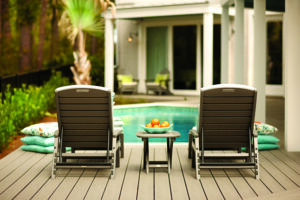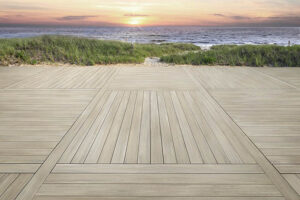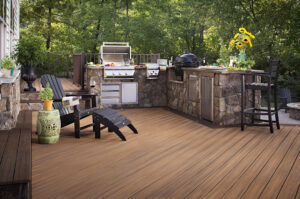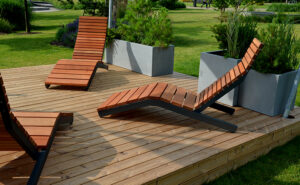You’re interested in adding a new deck to your home, but you’re unsure which type of deck is best. Well, don’t worry; we’re here to help you make the right decision for your outdoor space.
 In my many years working in the building and remodeling industry, I’ve learned that all types of decks come with their pluses and minuses. Traditional wood decks are the most budget-friendly but have the highest maintenance needs. Composite decks are made from recycled materials and are known for their beauty, durability, and low maintenance. Also needing less maintenance, PVC decks offer a more luxurious look and a higher price tag.
In my many years working in the building and remodeling industry, I’ve learned that all types of decks come with their pluses and minuses. Traditional wood decks are the most budget-friendly but have the highest maintenance needs. Composite decks are made from recycled materials and are known for their beauty, durability, and low maintenance. Also needing less maintenance, PVC decks offer a more luxurious look and a higher price tag.
To know which deck is right for you, let’s break down the pros and cons of each a little more.
PVC Decking

I find that most consumers use the terms vinyl decking and PVC decking interchangeably, but they are different. PVC, or polyvinyl chloride, deck boards are made from high-density plastics, but vinyl, while also a synthetic material, is more of a sheeting that rolls out to create a waterproof surface on top of other materials. PVC decks are a popular choice for homeowners who want a high aesthetic and a lot of style options.
Pros
PVC decking is the higher end of decking material, offering a luxury look and the most options in style. With a wide range of colors, patterns, and design options, homeowners have a lot of choices for the aesthetic of their PVC deck. PVC also offers excellent protection against weather, warping, damage, and fading. It won’t rot, mold, mildew, or splinter and doesn’t need maintenance, repainting, or re-staining. With a long lifespan and a long warranty, PVC decking is a worry-free investment.
Cons
Luxury and high-end mean bigger bucks, and that’s what you’ll find with PVC decking. Because it is made from plastics, homeowners who seek environmentally friendly products may be less interested, and it may be harder to achieve a natural or woodgrain look with PVC deck boards. Also, PVC decking can become hotter to the touch on sunny days.
Composite Decking
 Composite decking, made from recycled wood fibers and plastics, not only helps protect the environment but also creates an ideal deck environment for homeowners to spend time with their family and friends. Composite decks are known for being maintenance-free and durable and can easily be kept clean.
Composite decking, made from recycled wood fibers and plastics, not only helps protect the environment but also creates an ideal deck environment for homeowners to spend time with their family and friends. Composite decks are known for being maintenance-free and durable and can easily be kept clean.
Pros
Composite decking boards come in a variety of colors and styles and can look like wood. Due to their engineering and materials, composite decks can stand up better against weather, moisture, heat, and use, allowing them to have a long lifespan. Composite decking materials won’t splinter or rot, and they don’t need to be re-stained or repainted. Personally, I think the lack of maintenance and durability are some of their best attributes.
Cons
Composite deck boards can suffer scratches, and their color might begin to fade after years of direct sunlight. They are also more expensive than wood. While most decks are best built by a professional, composite decks (and PVC decks) are better constructed by a practiced hand for safety and security.
Wood Decking

Real wood was the original decking material long before the invention of composite and PVC materials. That, and its lower price point, make pressure-treated wood the most common material for deck building. But even with its popularity and benefits, I think homeowners need to understand what it takes to keep a wooden deck safe and beautiful.
Pros
Wood is the most cost-friendly option for decking material. It is also a natural element, with a natural look and wood grain, versus an engineered product. Because wood can be stained or painted, you can change up the look and vibe of your deck if your aesthetic changes over the years.
Cons
Wooden decks are more prone to damage from weather, insects, and improper usage. Dragging furniture, drippings from a grill, or lack of cleaning can lead to stains, mold, and splintering. Homeowners must be committed to ongoing maintenance and cleaning if they want to maintain the beauty and health of a wooden deck. I recommend that homeowners clean their decks twice a year (spring and fall) and re-stain or repaint them once every couple of years. Due to the necessary maintenance, what you saved on upfront costs may diminish in the long run. Lastly, even with good maintenance, a wooden deck has a shorter lifespan than composite or PVC.
Which One Should You Choose?
When considering your type of decking, homeowners should compare their features.
|
|
Composite | PVC |
Wood |
| Aesthetic | Variety of colors, styles and textures; can resemble natural wood | Variety of colors, styles and textures; luxury | Natural wood, organic |
| Cost | Up to $13 per square foot, on average | Up to $15 per square foot, on average | Up to $6 per square foot, on average |
| Durability | Excellent | Excellent | Good |
| Life Span | 25-30 years | 30+ years | 10-30 years |
| Maintenance | Low | Low | Regular |
| Resistance to Elements | Excellent | Excellent | Good |
As you can tell, there are many decking options for your home, and each option has pros and cons. The type of deck you choose will depend on your preference, lifestyle, and budget. Regardless of your decision, you will have a beautiful deck to enjoy with family and friends for years to come.